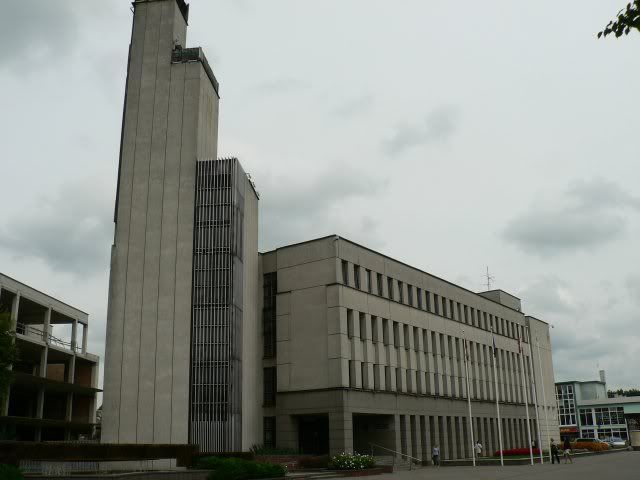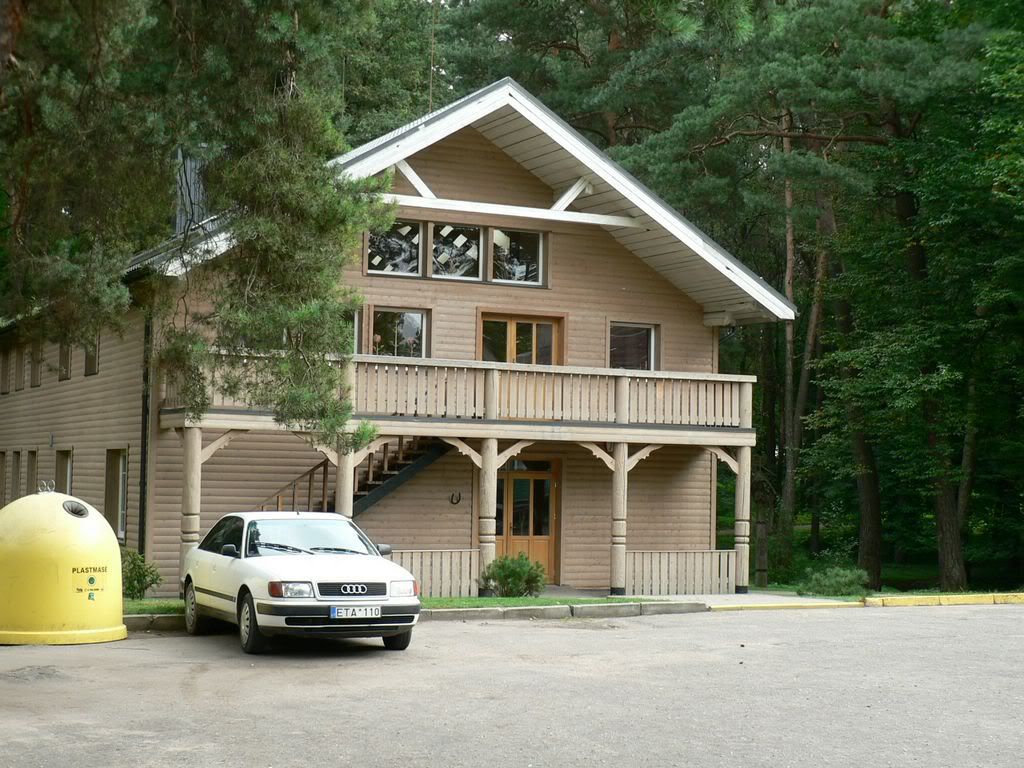Alytus - around the central park
The center of Alytus was rather artificially developed in around the central park in 1985-1990. And since the economic and legal basis changed significantly after 1990 the initial plans remained not relaized fully. But today we will make a short walk in this part of the town:

The area around the park with freedom monument is unofficially called "Kurortas". It means that this part of the town is full of green areas. From the early XXth century this part of the town attracted local richer people. In the 1980s urban planners decided to develop the new town center at the one side of the park. The central component of the new plan was the new building of local municipality. For the 1980s it was interesting and brave solution - the new municipality should resemble the old town halls (rathauses). This project was realized in 1987-1989 (arch. Saulius Juškys):

Next to the municipality building new town culture palace was planned. This project wasn't realized fully: it was built , later redesigned and only now new reconstruction approaches the finish:

Behind the municipality you can find remaining shop building probably from 1960s. It is very rare case in this country that shop building from that period survived up to our days. And the shop wasn't typical for that period:

Especially if you will look to the shop from behind:

Old cinema "Dainava" near the shop - also "avantgard" of the 1960s. But project was typical - at least one such building I know in Kaunas:

In front of the municipality you can see several modern buildings as this hotel:

Or modern reconstructions of older houses: such style becomes more and more popular here what began to frighten me ...

Another typical administrative building from 1970s:

Court building almost in the park: it's dating is very difficult to me. From one side this building has the memorial table in this building Gestapo and NKVD offices were located. Stylistically it could be dated by the 1980s. But the record from Roman times "Justitia est fundamentum regnorum" (Justice is the basis of the state) which was very popular in Lithuania before WWII may reference to the modern era:


Swedbank building nearby - the result of wild early 1990s:

In the park you can find several buildings of art school. One of them is clearly new one built in the "pseudohistoric" style ... Ooh ...

At the other side of the park - Adolfas Ramanauskas-Vanagas school building. The old part was built in 1920s , newer probably in 1970s or 1980s. After recent thermoinsulation it looks like that:

In front of the school I found monumental sculpture of Kazimieras Klimavičius. This personality was unknown to me. Later I found that he was a teacher in this school and was an author of many textbooks widely adopted in schools in this country from 1900s to 1950s. And that made me joyful - there are no to many monuments to the Teacher:

The urban structure at the other side of the park (and nominally further from the center) is very eclectic. Here you can find modern office of the local branch of Lithuanian public radio and TV:

New local stadium:

Houses of local well to do residents:

Primary school:

Some older residential buildings which probably survived several reconstructions:

And typical commieblocks from the 1970s and 1980s. Some of them undergoing renovation and changing their face:

Then I decided to return back to the center ...

counter widget

The area around the park with freedom monument is unofficially called "Kurortas". It means that this part of the town is full of green areas. From the early XXth century this part of the town attracted local richer people. In the 1980s urban planners decided to develop the new town center at the one side of the park. The central component of the new plan was the new building of local municipality. For the 1980s it was interesting and brave solution - the new municipality should resemble the old town halls (rathauses). This project was realized in 1987-1989 (arch. Saulius Juškys):

Next to the municipality building new town culture palace was planned. This project wasn't realized fully: it was built , later redesigned and only now new reconstruction approaches the finish:

Behind the municipality you can find remaining shop building probably from 1960s. It is very rare case in this country that shop building from that period survived up to our days. And the shop wasn't typical for that period:

Especially if you will look to the shop from behind:

Old cinema "Dainava" near the shop - also "avantgard" of the 1960s. But project was typical - at least one such building I know in Kaunas:

In front of the municipality you can see several modern buildings as this hotel:

Or modern reconstructions of older houses: such style becomes more and more popular here what began to frighten me ...

Another typical administrative building from 1970s:

Court building almost in the park: it's dating is very difficult to me. From one side this building has the memorial table in this building Gestapo and NKVD offices were located. Stylistically it could be dated by the 1980s. But the record from Roman times "Justitia est fundamentum regnorum" (Justice is the basis of the state) which was very popular in Lithuania before WWII may reference to the modern era:


Swedbank building nearby - the result of wild early 1990s:

In the park you can find several buildings of art school. One of them is clearly new one built in the "pseudohistoric" style ... Ooh ...

At the other side of the park - Adolfas Ramanauskas-Vanagas school building. The old part was built in 1920s , newer probably in 1970s or 1980s. After recent thermoinsulation it looks like that:

In front of the school I found monumental sculpture of Kazimieras Klimavičius. This personality was unknown to me. Later I found that he was a teacher in this school and was an author of many textbooks widely adopted in schools in this country from 1900s to 1950s. And that made me joyful - there are no to many monuments to the Teacher:

The urban structure at the other side of the park (and nominally further from the center) is very eclectic. Here you can find modern office of the local branch of Lithuanian public radio and TV:

New local stadium:

Houses of local well to do residents:

Primary school:

Some older residential buildings which probably survived several reconstructions:

And typical commieblocks from the 1970s and 1980s. Some of them undergoing renovation and changing their face:

Then I decided to return back to the center ...
counter widget